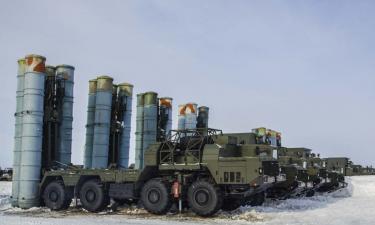Kursk Submarine Sank Because of US-Soviet Arms Race
On August 12th, Russia marked ten years since the Kursk submarine disaster - the largest tragedy in the history of the Russian navy, which claimed the lives of 118 men.

Many versions of the death of the nuclear submarine were discussed: the plundering of equipment, the launch of a missile from the Pyotr Veliki cruiser, a WWII mine, the lamentable situation of the navy during the 1990s and others.
Pravda.Ru was the first publication to set forth the version of Kursk's collision with an American submarine. French film director Jean-Michel Carre made a documentary based on this supposition: "Kursk, A Submarine in Troubled Waters" (2005).
The Russian governmental commission concluded in 2002 that the submarine had sunk as a result of the on-board torpedo explosion. The criminal case filed into the sinking of the submarine was closed two years later.
Russia Today: Kursk submarine tragedy remembered ten years later
Statistic data say that Russian submarines sink more often than foreign ones do. After 1945, the Navy of the USSR and then of the Russian Federation has lost 16 submarines. Seven of them were nuclear-powered: K-8 on April 8, 1970; K-56 on June 14, 1973, K-429 on June 24, 1983, K-219 on October 3, 1986, K-278 Komsomolets on April 7, 1989, K-141 Kursk on August 12, 2000, K-159 on August 30, 2003.
The list continues with nine diesel subs: December 15, 1952 - S-117 Makrel, November 23, 1956 - M-200 Mest, August 22, 1957 - M-351, September 26, 1957 - M-256, January 26, 1961 - S-80, January 11, 1962 - B-37 and C-350, March 8, 1968 - K-129, October 21, 1981 - S-178.
The US Navy has lost four submarines (some sources say three) during the post-war period. Two of the lost US subs were nuclear powered. Nine diesel submarines of other countries sank during that time (two British, two French, one Israeli, one German, one Peruvian, one Brazilian and one Chinese).
It is worthy of note that the number of Russia's operating submarines doubles the number of US subs. The number of submariners killed in accidents with all foreign fleets totals 585 people during peace time. The sad list of the Soviet and Russian navy has 857 people on.
Konstantin Sivkov, the first vice president of the Academy of Geopolitical Problems, said in an interview with Pravda.Ru that such a high percentage of accidents with Russian submarines can be explained with the fact that the submarines were operating far away from the Russian waters.
"Russia could not provide its assistance to troubled submarines if they were too far. The system of the navy rescue force was virtually destroyed in Russia during the 1990s. Most of it was either sold or leased to foreigners. The low quality of the personnel training also affects the situation in general. Many professionals were fired, and they were replaced with less experienced people, especially in the command," the specialist said.
Pavel Zolotarev, deputy director of the Institute for the US and Canada of the Russian Academy of Sciences, said that the sad statistics was the result of the arms race during the Cold War period.
"The Soviet Union very often had to accept underdeveloped military hardware for operation. Soviet officials believed that the problems could be solved afterwards, during the exploitation period. Such a decision claimed many people's lives. Unlike the Russians, the Americans, as well as other nations, wanted to develop their military hardware to the utmost.
"There is nothing surprising about it. Here the life of a human being is treated as something secondary. Just try to recollect the songs of those times, which would tell, let's say, the story of a man, who died, but saved a tractor, for example.
"Nowadays, we have a different type of problems in the navy. First and foremost, the system of defense acquisitions and passing military hardware into service does not correspond to Russia's market economy. In the States, there are thousands of laws to regulate these issues, every detail is regulated meticulously," the scientist said.
Vladimir Khrustalev, an expert for nuclear technologies of Admiral Nevelsky State Maritime University:
"When comparing the fleet of nuclear submarines of Russia and the USA, it becomes clear that we highlighted the production of the maximum number of nuclear cruisers. The Americans had a different approach - they wanted to modernize their underwater nuclear force.
"The Soviet system was not economic at this point. Unlike the USA, Russia was spending the funds irrationally. Russia was producing one sub after another, and quality was not the priority. This affected the situation in the navy in general, and was subsequently reflected in sad statistic reports.
"Our economy was based on plans. It was probably a positive factor in some aspects, but it was definitely not the case with nuclear subs. Our designers were ordered to complete all the works within certain time periods when developing new nuclear subs. The USSR had to catch up with the USA, which very often entailed underdevelopments, excessive spending and would then result in production defects.
"The USA could access the technological power of the whole Western world, which was a considerable advantage. The US economy was larger than that of the USSR, and it was very hard for the USSR to compete with the Americans. However, Soviet specialists were building high-performance arms. Russia has a lot to catch up with the Soviet Union at this point. Soviet submarines became a very serious threat to the Western navy. If an armed conflict had occurred between the two countries, many NATO vessels would have been destroyed without a doubt."
Sergey Balmasov
Vadim Trukhachev
Pravda.Ru
Subscribe to Pravda.Ru Telegram channel, Facebook, RSS!




